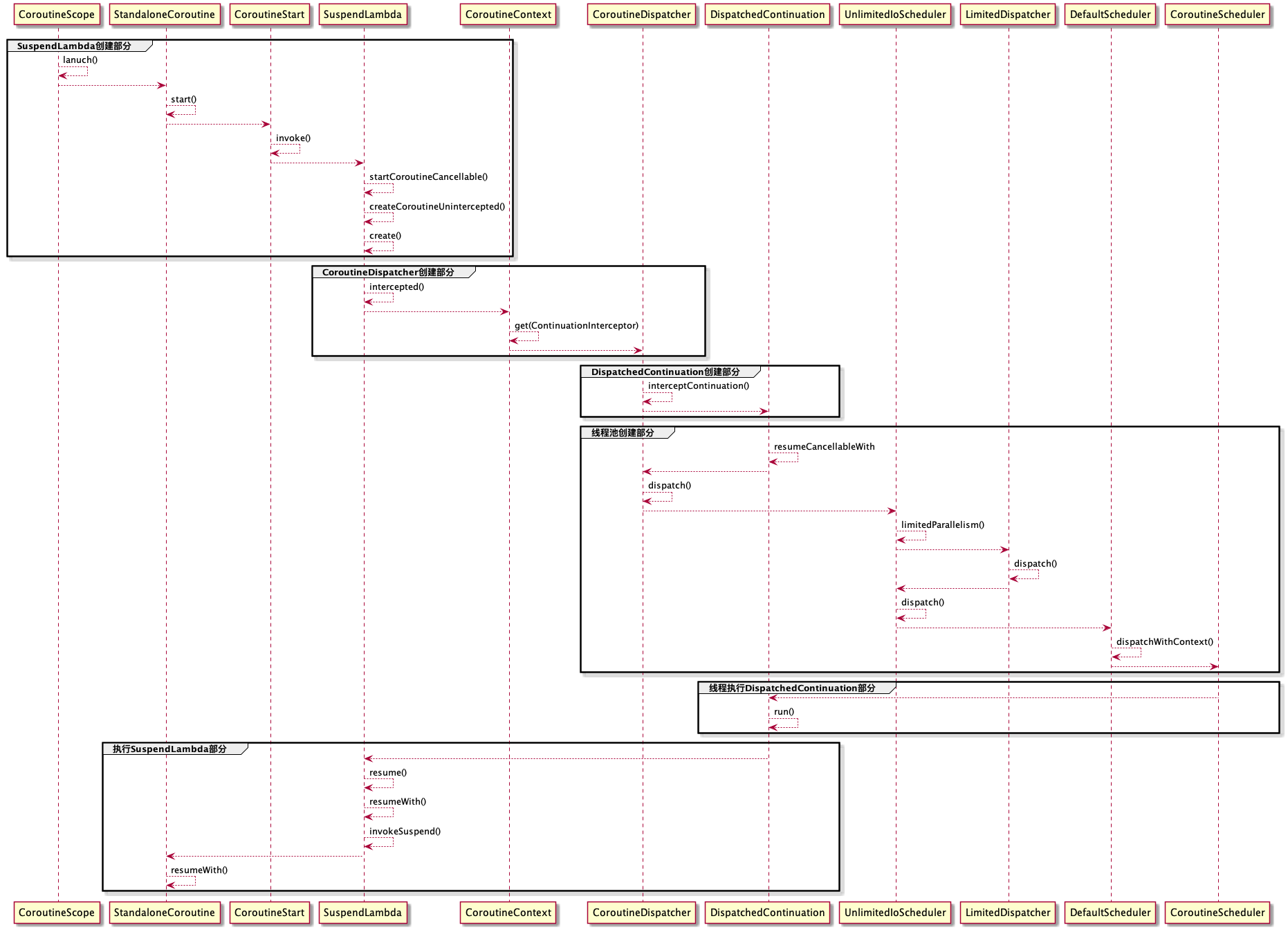在讲解如何切换线程之前,有必要先了解下CoroutineScope。协程作用域,它里面持有CoroutineContext,用来管理它的作用域范围内的所有协程。
CoroutineScope(协程作用域)
CoroutineScope组成
 可见它只是一个接口,里面定义了一个coroutineContext。前面介绍过coroutineContext是协程的上下文,它里面是由Element拼接而成的,而Element主要分为如下几种:
可见它只是一个接口,里面定义了一个coroutineContext。前面介绍过coroutineContext是协程的上下文,它里面是由Element拼接而成的,而Element主要分为如下几种:
- CoroutineDispatcher:它是线程分发器。其中Dispatcher.IO和Dispatcher.Main、Dispatchers.Main.immediate都是继承自于它
- Job:它是用来取消协程、父协程与子协程取得联系的桥梁。常见的有SupervisorJob
- CoroutineName:用来给协程起名字的作用
- CoroutineExceptionHandler:它是用来捕捉协程异常的回调器
所以完整的CoroutineContext组成部分如下: job+dispatchers+CoroutineName+CoroutineExceptionHandler
CoroutineScope分类
目前kotlin已经内置了各种CoroutineScope,下面来说下他们的区别
GlobalScope
上面用到的GlobalScope就是一个协程作用域:
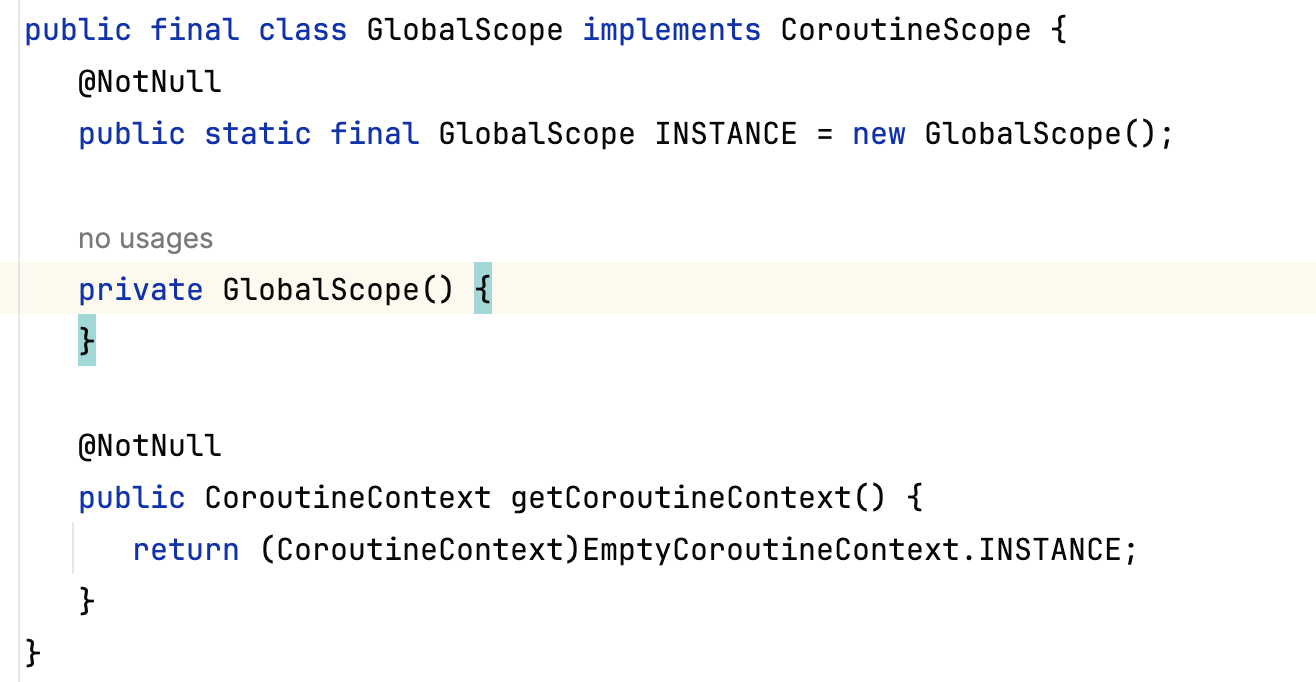 可以看出来它是一个单例的scope,生命周期和app保持一致,并且它的context是一个EmptyCoroutineContext。平时开发时候不会去用它
可以看出来它是一个单例的scope,生命周期和app保持一致,并且它的context是一个EmptyCoroutineContext。平时开发时候不会去用它
runBlocking
是一个阻塞式的协程作用域,会阻塞协程外面的线程,内部是通过java的LockSupport.park阻塞住线程来实现的。


MainScope
它是一个指定协程分发在主线程中,并且使用到的Job是SupervisorJob,它的作用是当子协程出错的时候,不影响到父协程中的其他子协程
 它是一个ContextScope,继承自CoroutineScope,并且它的context是由SupervisorJob()和Dispatchers.Main组成的一个context。我们一般自定义CoroutineScope的时候也是定义一个ContextScope,他的构造方法需要传入一个CoroutineContext。
它是一个ContextScope,继承自CoroutineScope,并且它的context是由SupervisorJob()和Dispatchers.Main组成的一个context。我们一般自定义CoroutineScope的时候也是定义一个ContextScope,他的构造方法需要传入一个CoroutineContext。

CoroutineScope顶级方法
 它也是一个ContextScope,它的上下文先看传进来的context中的job是否为空,如果为空,则初始化一个job。如果不为空,则使用传进来的context。
它也是一个ContextScope,它的上下文先看传进来的context中的job是否为空,如果为空,则初始化一个job。如果不为空,则使用传进来的context。
coroutineScope顶级方法
 它是一个suspend方法,它是通过闭包的形式返回一个CoroutineScope,对应的字节码如下:
它是一个suspend方法,它是通过闭包的形式返回一个CoroutineScope,对应的字节码如下:
 会将ScopeCoroutine给到block,也就是闭包中的CoroutineScope,接着会调用UndispatchedKt.startUndispatchedOrReturn:
会将ScopeCoroutine给到block,也就是闭包中的CoroutineScope,接着会调用UndispatchedKt.startUndispatchedOrReturn:
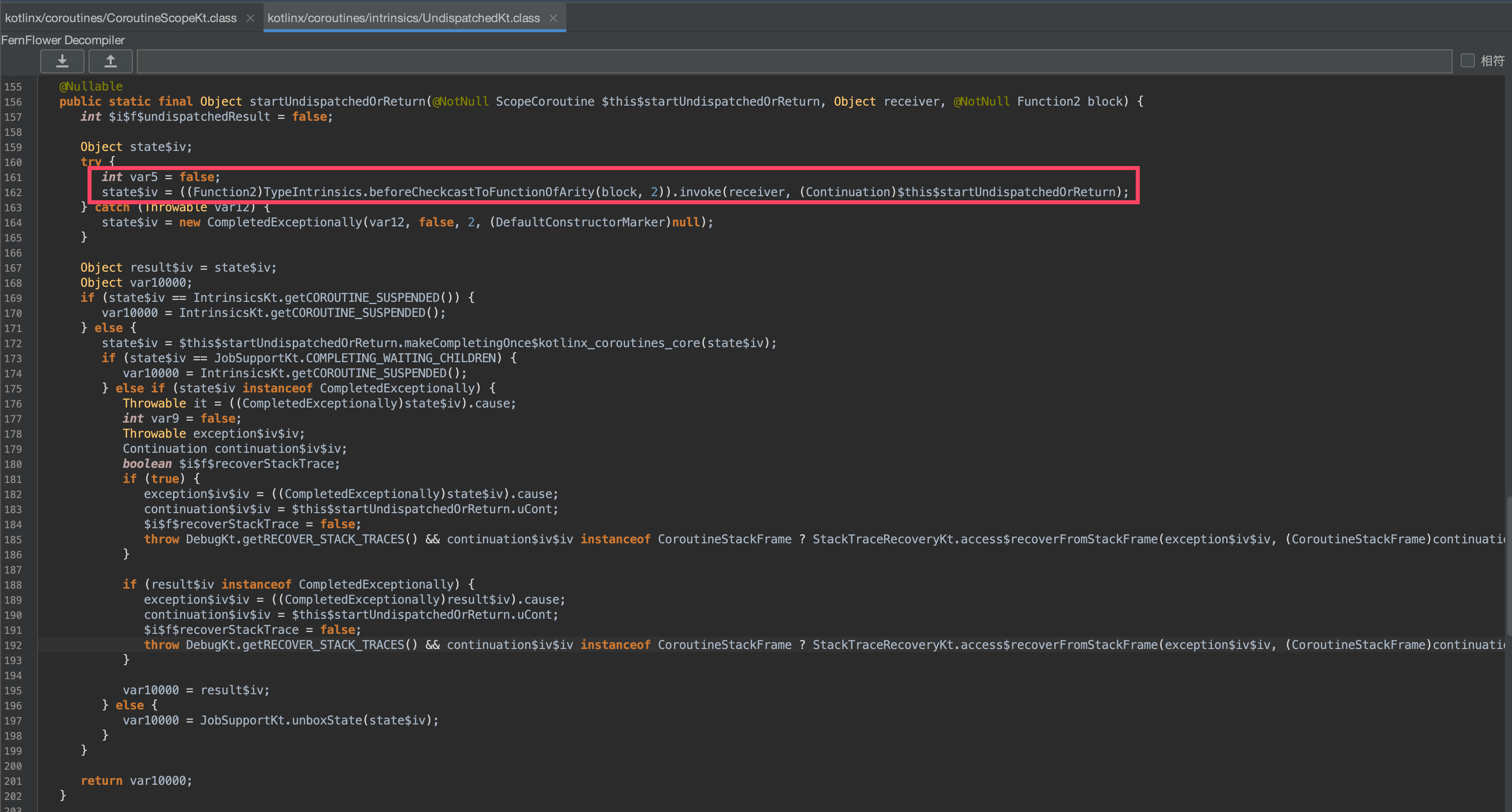 最终调用了block.invoke方法,写个demo看下效果:
最终调用了block.invoke方法,写个demo看下效果:
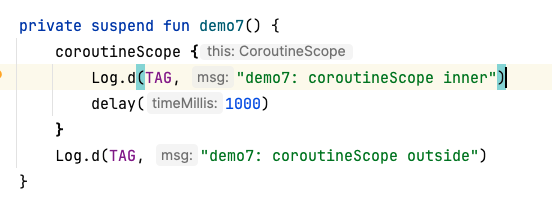 日志如下:
日志如下:
 从日志可以看出来,它是先等到coroutineScope里面delay执行完了,才执行外面的逻辑。在字节码层面,它会把coroutineScope外面的代码编译成SuspendLambda,它也是个Continuation,等到执行完了coroutineScope内部的代码,才会回调到coroutineScope外面的SuspendLambda中来:
从日志可以看出来,它是先等到coroutineScope里面delay执行完了,才执行外面的逻辑。在字节码层面,它会把coroutineScope外面的代码编译成SuspendLambda,它也是个Continuation,等到执行完了coroutineScope内部的代码,才会回调到coroutineScope外面的SuspendLambda中来:
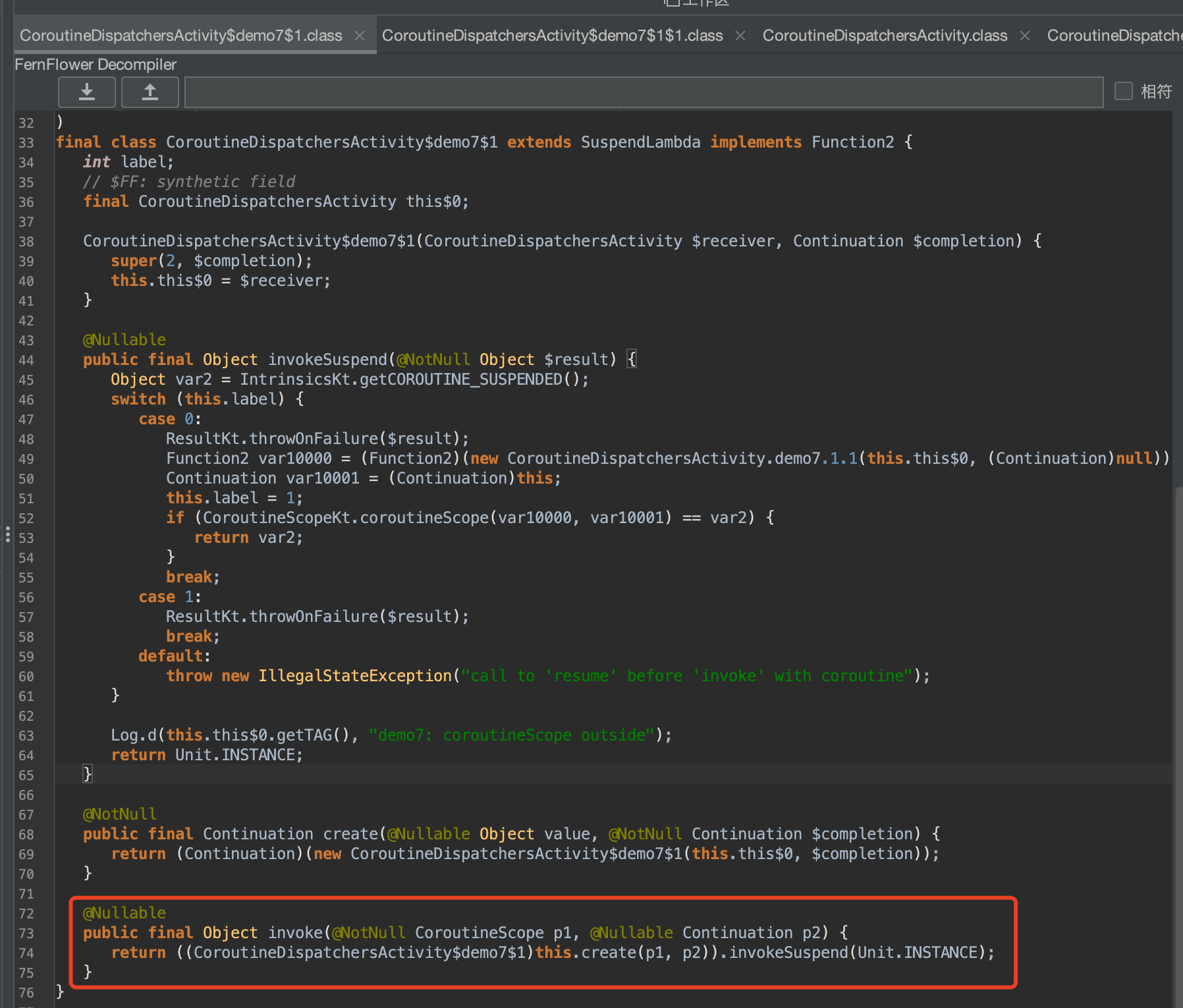 上面分析过UndispatchedKt.startUndispatchedOrReturn中调用了block的invoke方法,此处的block正对应了CoroutineDispatchersActivity$demo7$1这个SuspendLambda对象:
上面分析过UndispatchedKt.startUndispatchedOrReturn中调用了block的invoke方法,此处的block正对应了CoroutineDispatchersActivity$demo7$1这个SuspendLambda对象:
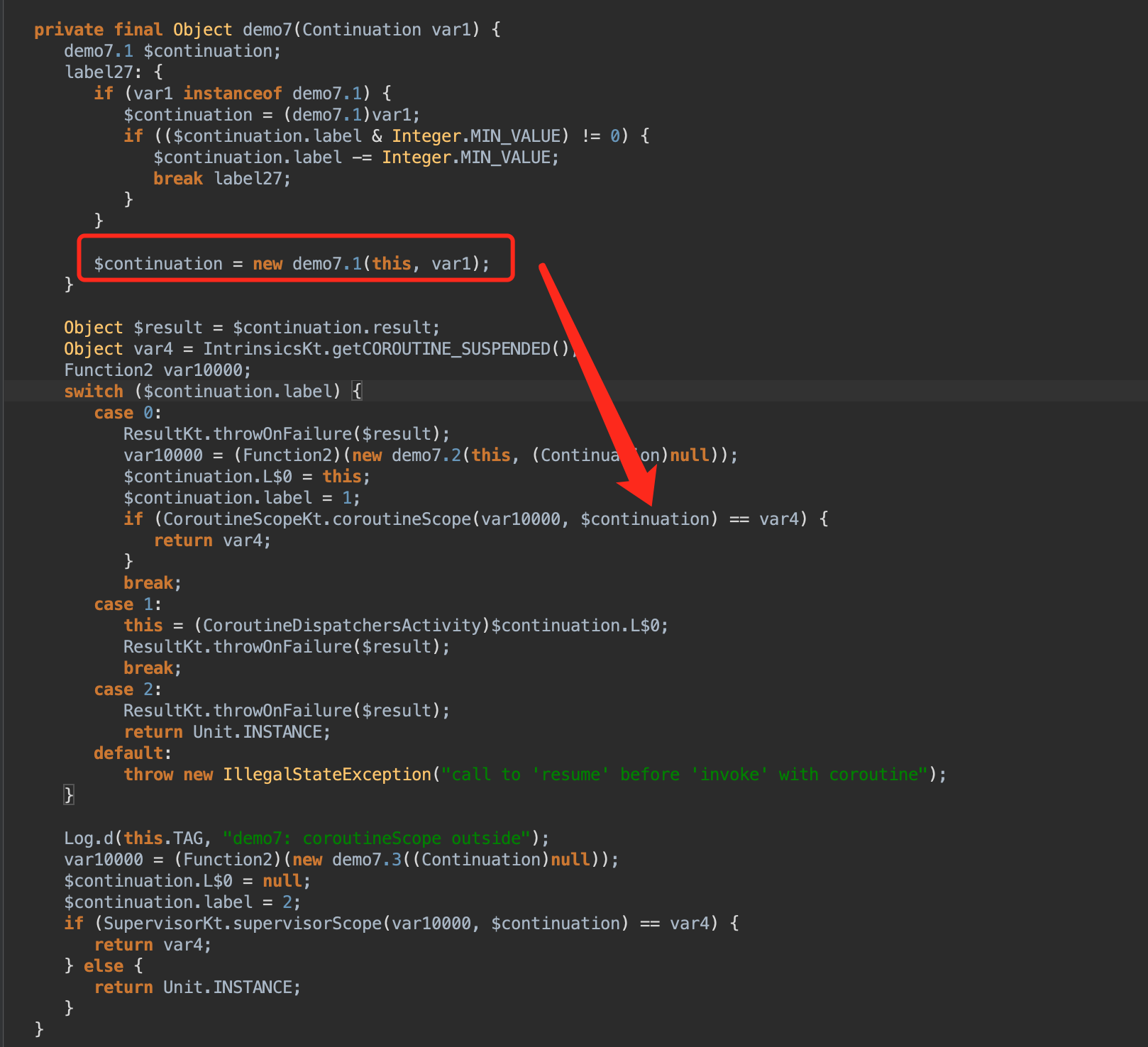 在demo7中将CoroutineDispatchersActivity$demo7$1这个continuation传递到coroutineScope中,而它的invoke方法如下:
在demo7中将CoroutineDispatchersActivity$demo7$1这个continuation传递到coroutineScope中,而它的invoke方法如下:
 创建了CoroutineDispatchersActivity$demo7$1后,继而调用了invokeSuspend方法,而invokeSuspend里面是要等到coroutineScope闭包中的delay挂起结束后,才会再次回到invokeSuspend方法,最后才会输出「demo7: coroutineScope outside」的日志,这也是协程挂起的调用顺序。
创建了CoroutineDispatchersActivity$demo7$1后,继而调用了invokeSuspend方法,而invokeSuspend里面是要等到coroutineScope闭包中的delay挂起结束后,才会再次回到invokeSuspend方法,最后才会输出「demo7: coroutineScope outside」的日志,这也是协程挂起的调用顺序。
supervisorScope顶级方法
它和上面的coroutineScope顶级方法差不多,也是先调用完闭包中的逻辑,然后才执行supervisorScope外面的代码。看下它的实现就知道区别了:
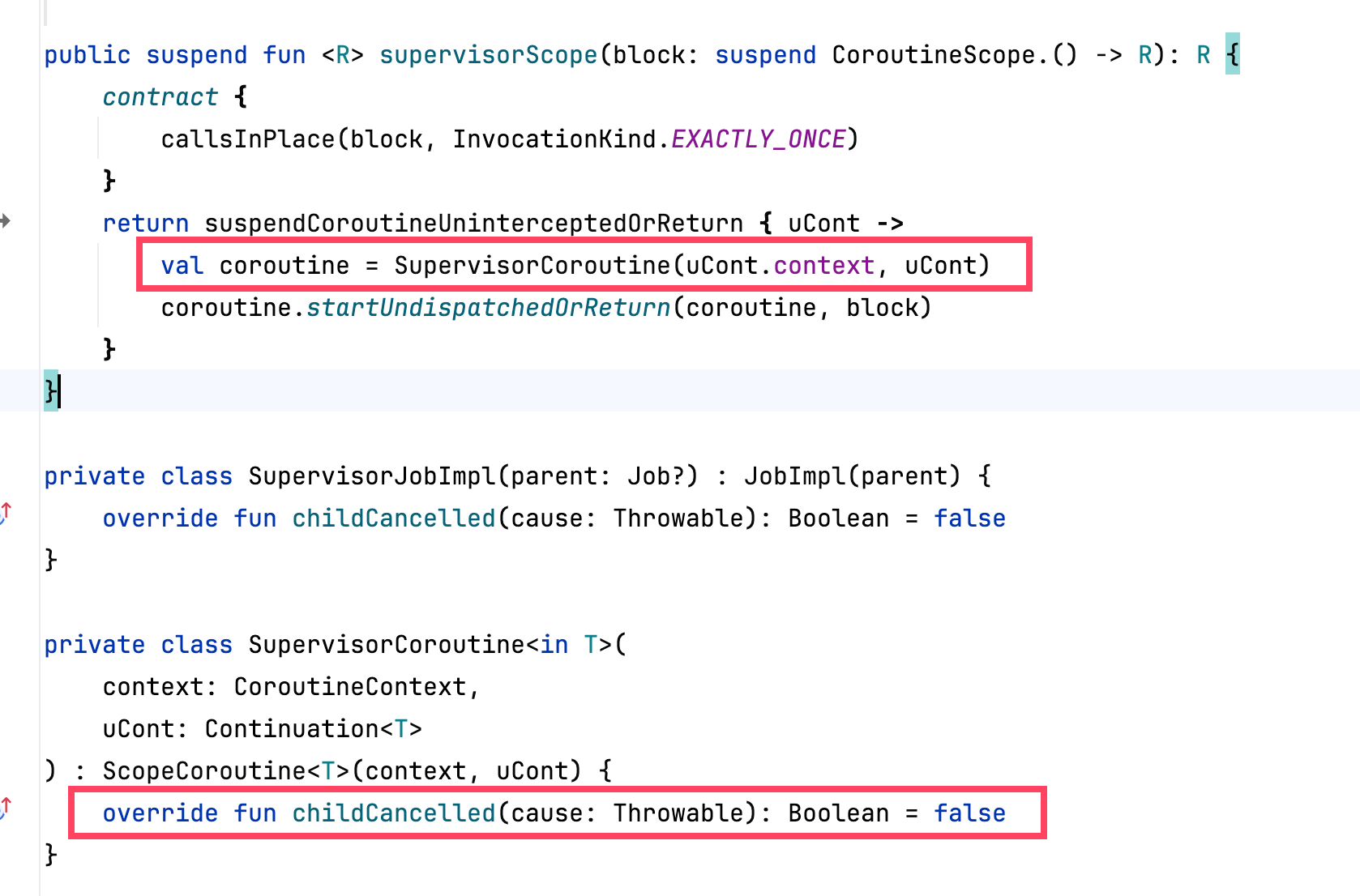 他所使用的CoroutineScope是一个SupervisorCoroutine,它和上面用到的ScopeCoroutine区别是重写了childCancelled方法,并返回false,此方法是子协程发生异常后,该不该取消其它的子协程,下面来验证下:
他所使用的CoroutineScope是一个SupervisorCoroutine,它和上面用到的ScopeCoroutine区别是重写了childCancelled方法,并返回false,此方法是子协程发生异常后,该不该取消其它的子协程,下面来验证下:
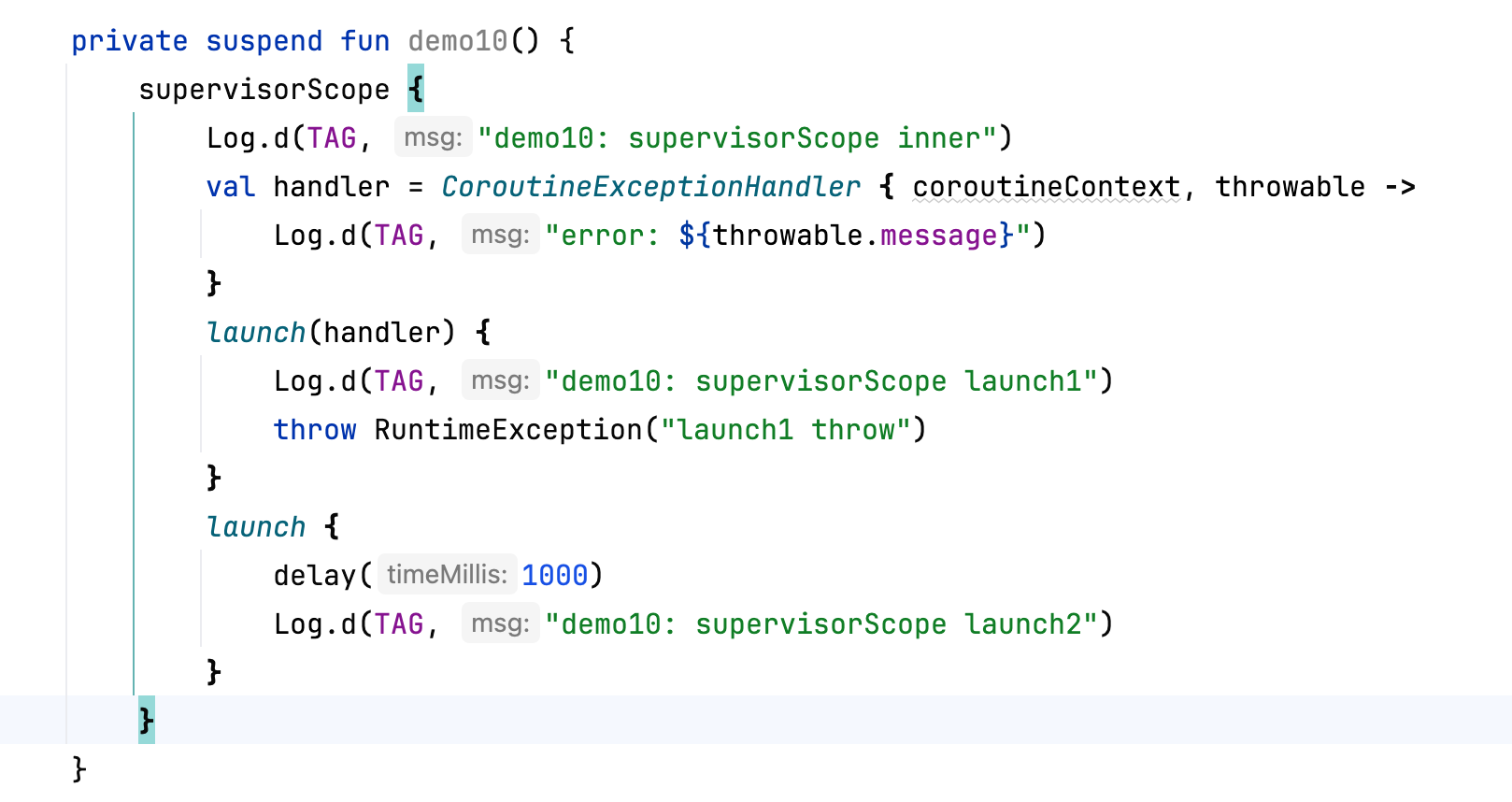
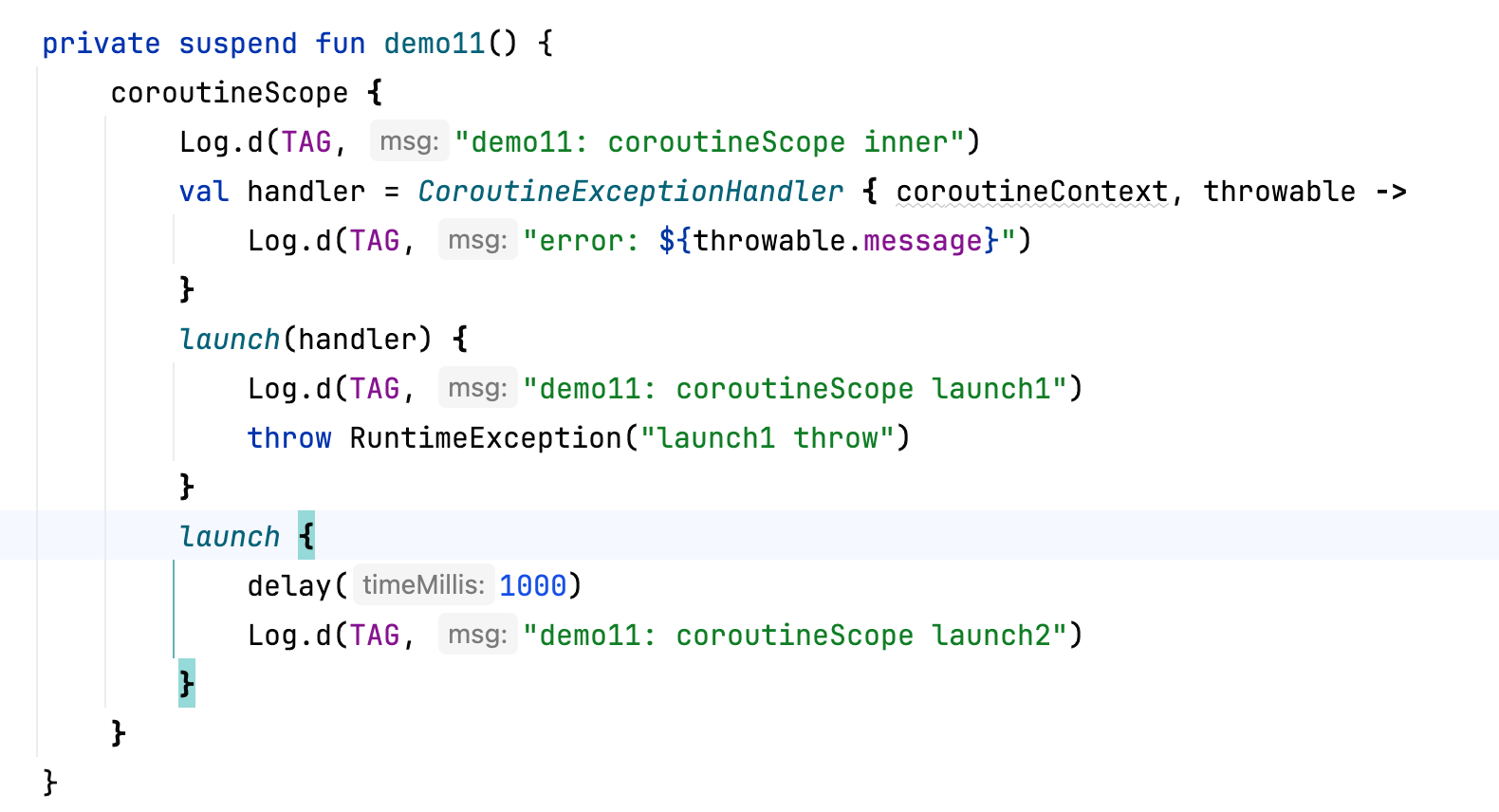 在supervisorScope闭包中launch1发生异常了,由于supervisorScope不会去处理异常,将异常交给了launch1处理,所以launch2中的代码能继续执行。而在coroutineScope中,当launch1发生异常的时候,会将异常交给了coroutineScope,最终导致launch2的协程无法继续执行。
在supervisorScope闭包中launch1发生异常了,由于supervisorScope不会去处理异常,将异常交给了launch1处理,所以launch2中的代码能继续执行。而在coroutineScope中,当launch1发生异常的时候,会将异常交给了coroutineScope,最终导致launch2的协程无法继续执行。
Job
Job实现了CoroutineContext.Element,可以用来取消、启动一个协程,并且和父协程绑定了关系:
 它下面有几个关键的子类:
它下面有几个关键的子类:
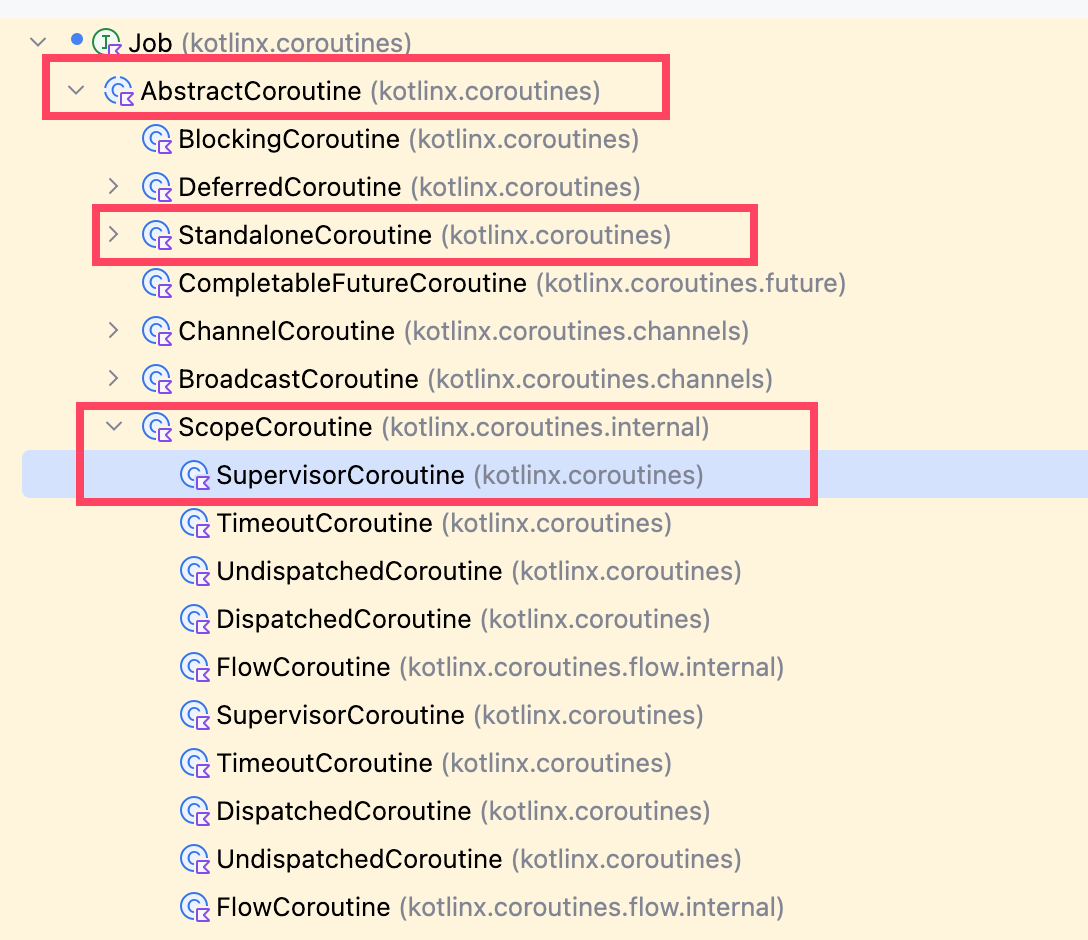 从图上可以看出来前面分析的coroutineScope和supervisorScope两个顶级方法所使用的作用域ScopeCoroutine最终也是一个Job。
从图上可以看出来前面分析的coroutineScope和supervisorScope两个顶级方法所使用的作用域ScopeCoroutine最终也是一个Job。
线程例子
先看一个例子:
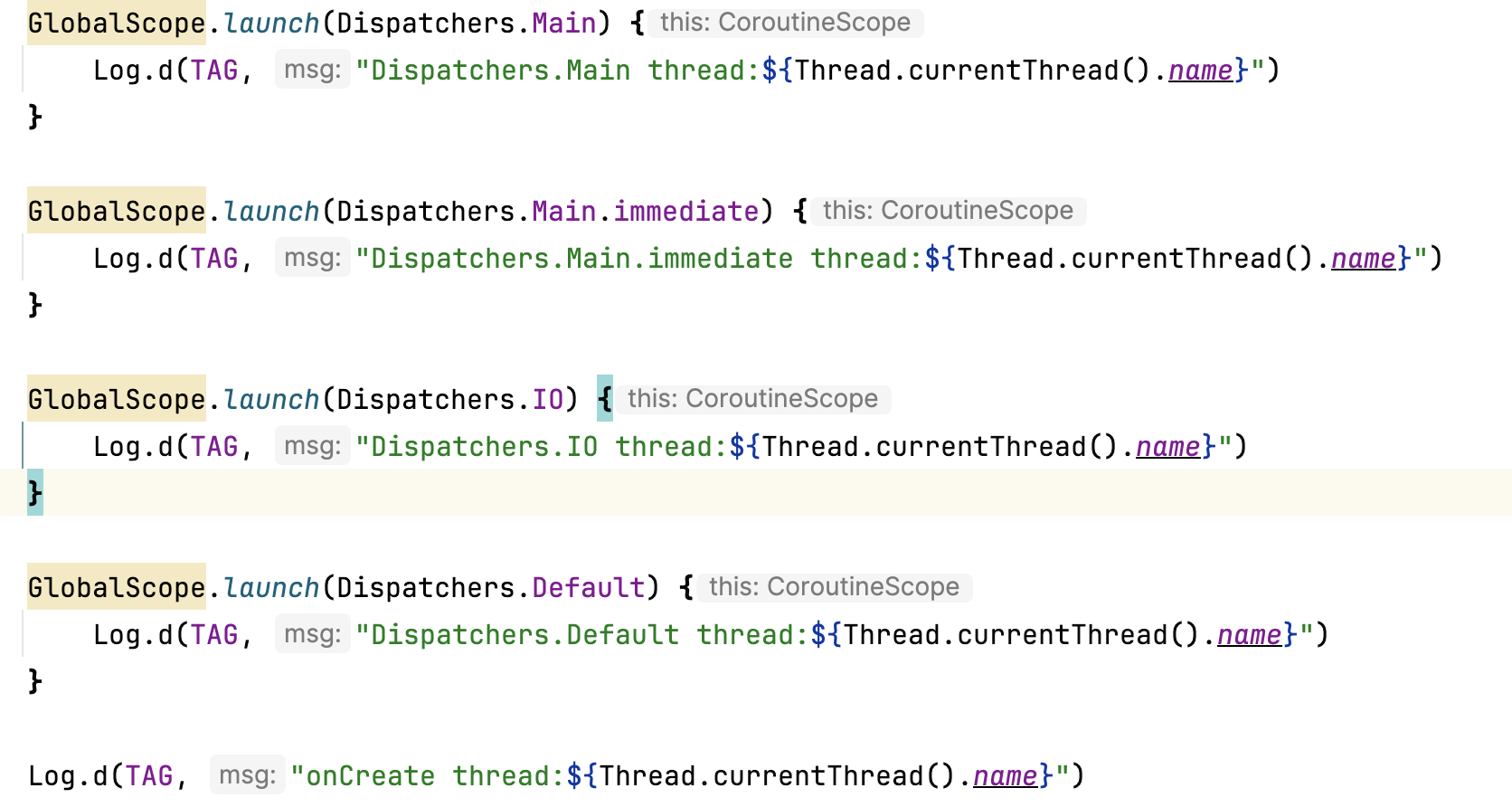
分别指定了四种线程的用法,日志如下:
第一次:
 第二次:
第二次:

Dispatchers.Main.immediate:指定的主线程会最先执行
Dispatchers.Main:指定的主线程会晚于协程外面的主线程
Dispatchers.IO和Dispatchers.Default:指定的线程没有先后之分
CoroutineScope.lanuch
lanuch方法是协程作用域的扩展方法,比如上面例子中的GlobalScope它就是继承自CoroutineScope:
|
|
- 参数:
- context:launc传进来的context,比如上面例子中传进来的Dispatchers.Main、Dispatchers.IO这些都是CoroutineContext。如果没传就用EmptyCoroutineContext。
- start:CoroutineStart的枚举类,表示启动模式,默认是DEFAULT
- block:协程代码块,是一个CoroutineScope的扩展挂起函数
- 将外界传进来的context和当前CoroutineScope的context进行合并处理
- 默认是DEFAULT模式,所以会初始化一个StandaloneCoroutine,会把newContext作为自己的parentContext,它既是一个Continuation,也是一个CoroutineScope
- 调用StandaloneCoroutine的start方法,并把启动模式,StandaloneCoroutine,协程挂起函数传进去了
- StandaloneCoroutine作为lauch的返回值
StandaloneCoroutine它是一个Job类型,也是继承自AbstractCoroutine,看下它的start方法:
 这里调用了start变量的invoke方法,因为CoroutineStart重写了invoke方法,所以能直接这么调,相当于是一个闭包的调用方式,这里调用了三参的invoke:
这里调用了start变量的invoke方法,因为CoroutineStart重写了invoke方法,所以能直接这么调,相当于是一个闭包的调用方式,这里调用了三参的invoke:

- 第一个参数:挂起函数闭包,也就是协程要执行的代码块
- 第二个参数:start方法传进来的StandaloneCoroutine
- 第三个参数:start方法传进来的this,也是StandaloneCoroutine
CoroutineStart是DEFAULT类型,所以会调用挂起函数的startCoroutineCancellable方法:
 在上面分析createCoroutine时候也是通过createCoroutineUnintercepted(receiver, completion).intercepted(),创建了delegate,最终是一个Continuation,也是一个suspendLambda。我们直接看ContinuationImpl的intercepted方法:
在上面分析createCoroutine时候也是通过createCoroutineUnintercepted(receiver, completion).intercepted(),创建了delegate,最终是一个Continuation,也是一个suspendLambda。我们直接看ContinuationImpl的intercepted方法:
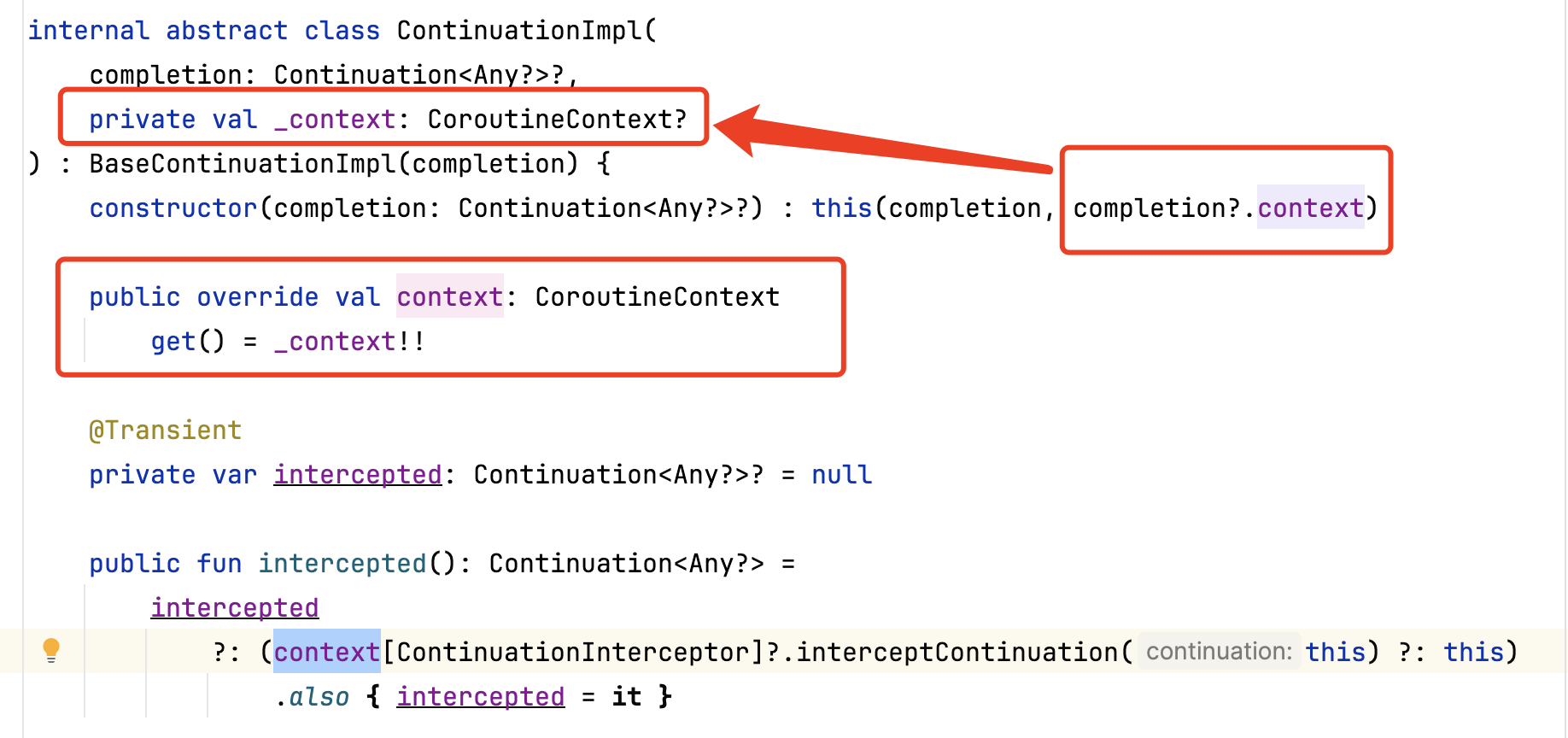 intercepted方法里面取context变量中的key为ContinuationInterceptor的context,而context最终是completion的context,completion是前面start方法传进来的StandaloneCoroutine,它是继承自AbstractCoroutine:
intercepted方法里面取context变量中的key为ContinuationInterceptor的context,而context最终是completion的context,completion是前面start方法传进来的StandaloneCoroutine,它是继承自AbstractCoroutine:
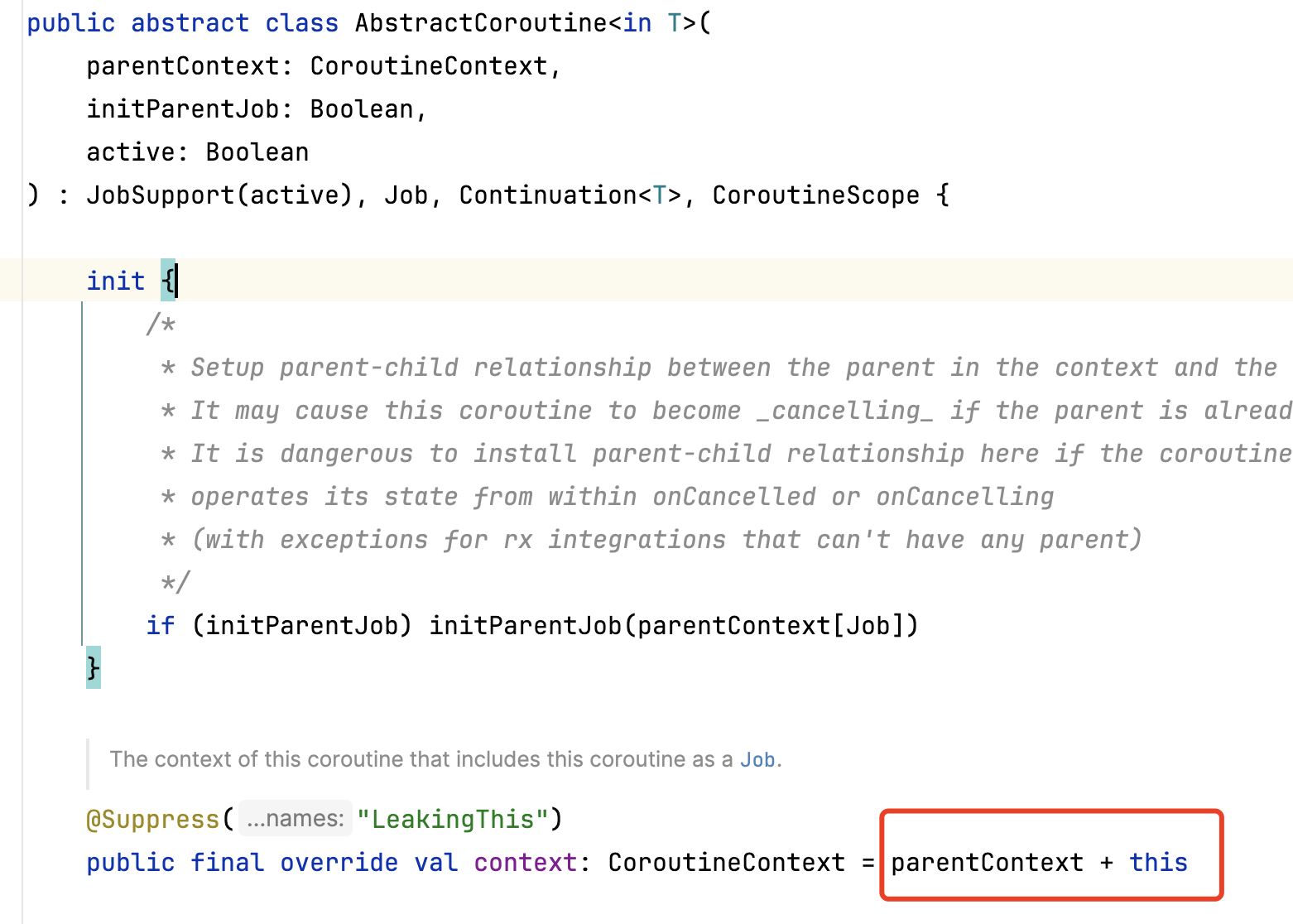 parentContext是launch方法传进来的context+CoroutineScope自己的context拼接的一个context
this:AbstractCoroutine实现了job接口,job也是一个CoroutineContext
在上面例子中lauch方法是通过GlobalScope启动的,它的context是一个EmptyCoroutineContext,所以传给AbstractCoroutine的parentContext其实就是launch方法传进去的context,也就是Dispatchers.io、Dispatchers.main等。
回到ContinuationImpl的intercepted方法,取context的ContinuationInterceptor,然后调用interceptContinuation方法,看下Dispatchers.io,它最终继承自CoroutineDispatcher:
parentContext是launch方法传进来的context+CoroutineScope自己的context拼接的一个context
this:AbstractCoroutine实现了job接口,job也是一个CoroutineContext
在上面例子中lauch方法是通过GlobalScope启动的,它的context是一个EmptyCoroutineContext,所以传给AbstractCoroutine的parentContext其实就是launch方法传进去的context,也就是Dispatchers.io、Dispatchers.main等。
回到ContinuationImpl的intercepted方法,取context的ContinuationInterceptor,然后调用interceptContinuation方法,看下Dispatchers.io,它最终继承自CoroutineDispatcher:
 结论:
如果lauch传的是Dispatchers.io,则lauch先创建DispatchedContinuation,然后调用resumeCancellableWith方法:
结论:
如果lauch传的是Dispatchers.io,则lauch先创建DispatchedContinuation,然后调用resumeCancellableWith方法:
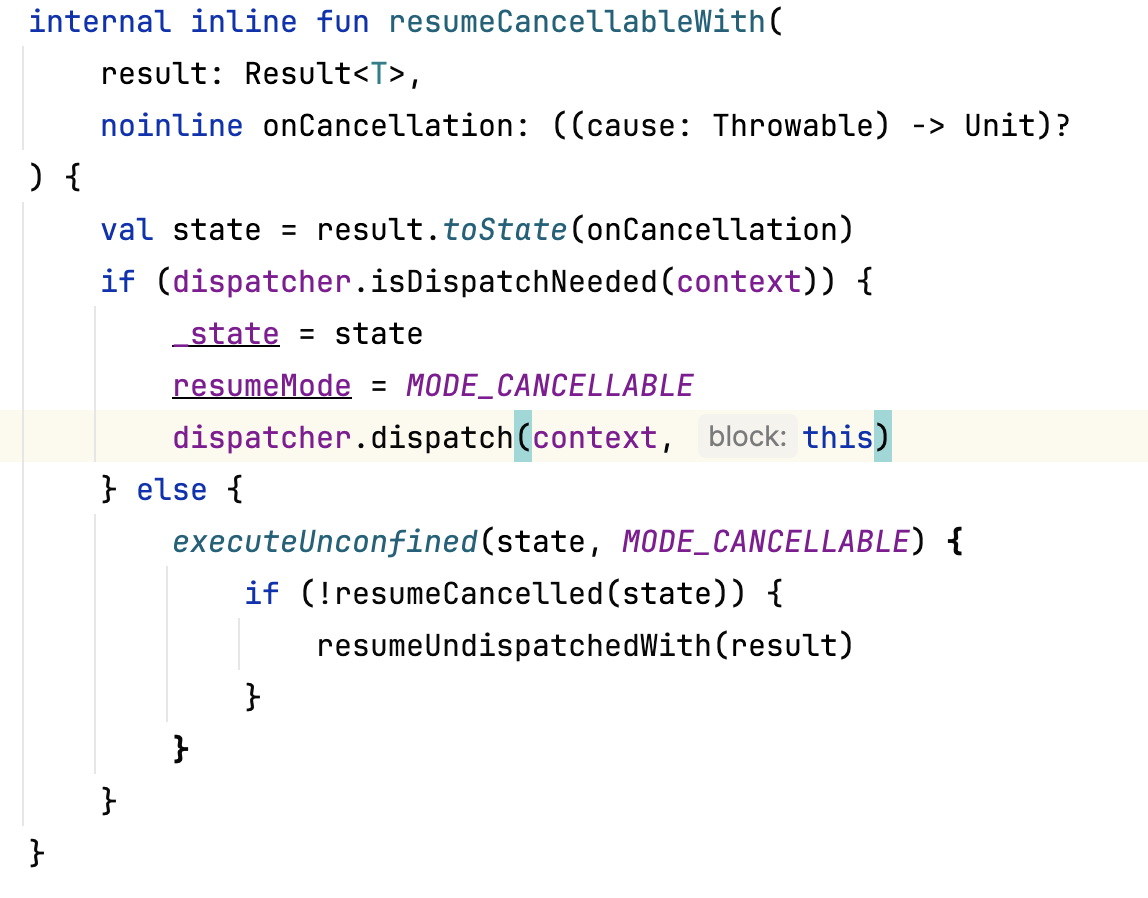 如果dispatcher.isDispatchNeeded(默认是true),才会进入到dispatch逻辑,看下dispatchers.io:
如果dispatcher.isDispatchNeeded(默认是true),才会进入到dispatch逻辑,看下dispatchers.io:
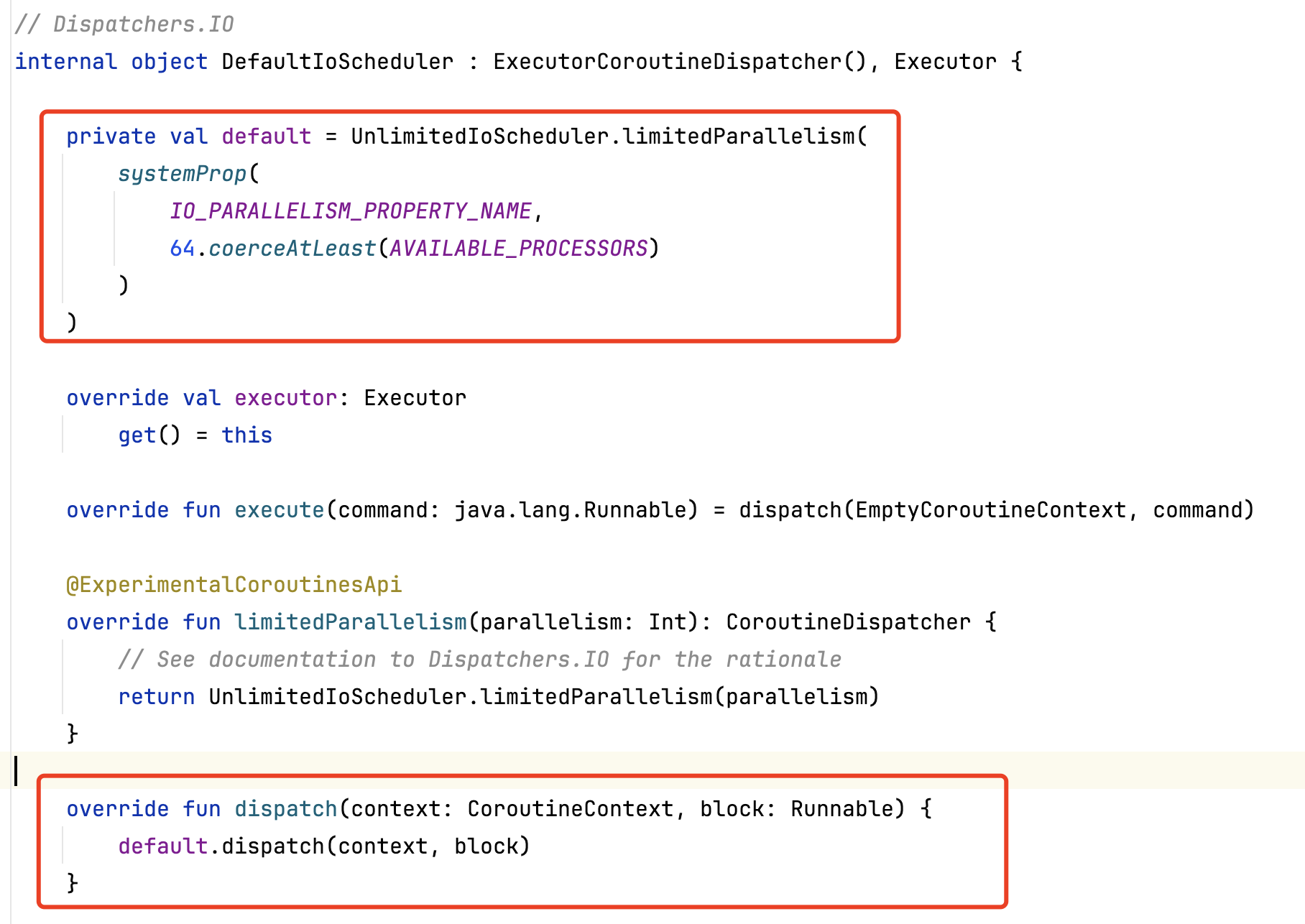 调用了default.dispatch方法,diefault是由UnlimitedIoScheduler.limitedParallelism创建的LimitedDispatcher,最终会执行到UnlimitedIoScheduler.dispatch方法:
调用了default.dispatch方法,diefault是由UnlimitedIoScheduler.limitedParallelism创建的LimitedDispatcher,最终会执行到UnlimitedIoScheduler.dispatch方法:
 DefaultScheduler的dispatchWithContext方法如下:
DefaultScheduler的dispatchWithContext方法如下:
 coroutineScheduler创建如下:
coroutineScheduler创建如下:
 最终会执行到CoroutineScheduler的dispatch方法,里面的代码就不细看了,是线程池部分执行block,关于这部分后面可以深究下,而block是在DispatchedContinuation中resumeCancellableWith方法里面把this给到了dispatcher的dispatch方法,说明DispatchedContinuation实现了Runnable接口,直接看它的run方法,该方法定义在它的父类DispatchedTask中:
最终会执行到CoroutineScheduler的dispatch方法,里面的代码就不细看了,是线程池部分执行block,关于这部分后面可以深究下,而block是在DispatchedContinuation中resumeCancellableWith方法里面把this给到了dispatcher的dispatch方法,说明DispatchedContinuation实现了Runnable接口,直接看它的run方法,该方法定义在它的父类DispatchedTask中:
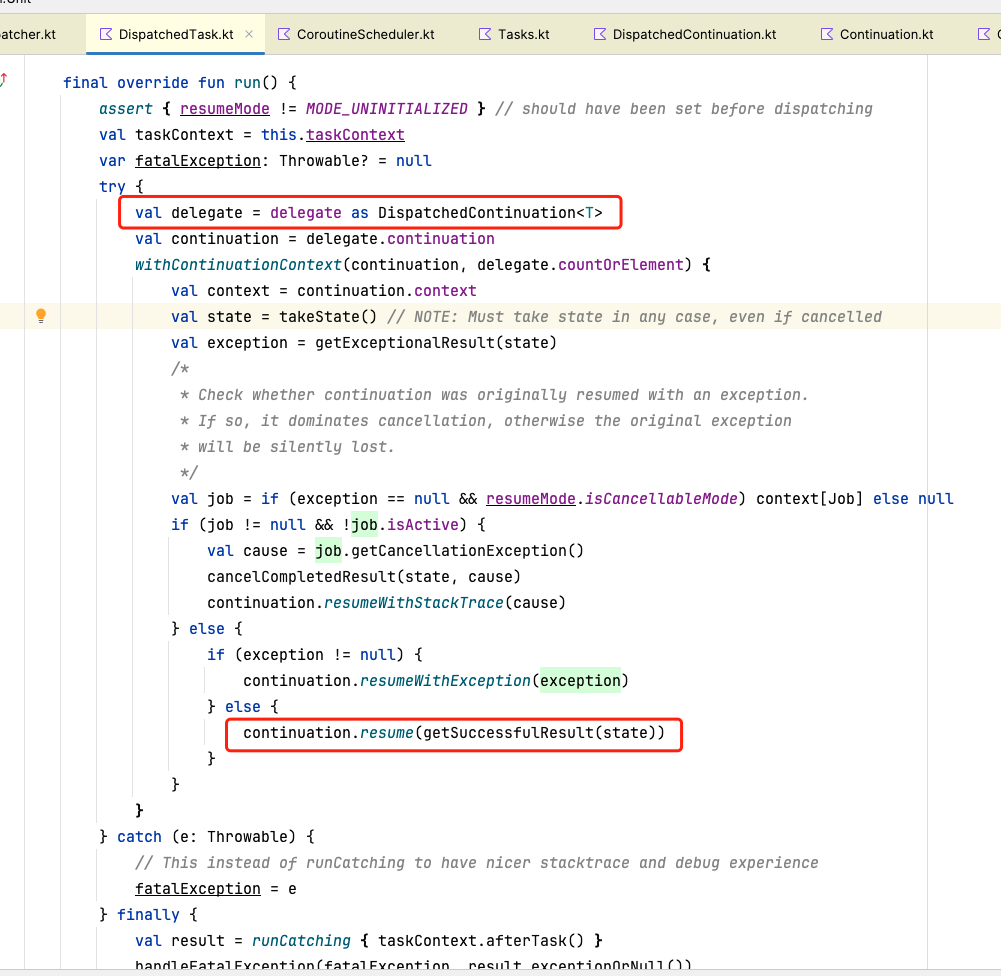 此处执行了delegate的resume方法,resume方法执行了resumeWith,注意此处的delegate是DispatchedContinuation中传进来的continuation,它是createCoroutineUnintercepted(receiver, completion).intercepted()创建的delegate,是一个continuation对象,也是suspendlambda,在上面创建协程分析过baseContinuationImpl的resumeWith方法,里面会执行协程的invokeSuspend方法,也就是我们的协程执行代码。执行完了后会执行complete的resumeWith,而通过lauch创建的协程,此处的complete是launch方法构造的StandaloneCoroutine对象,它的resumeWith方法定义在AbstractCoroutine中:
此处执行了delegate的resume方法,resume方法执行了resumeWith,注意此处的delegate是DispatchedContinuation中传进来的continuation,它是createCoroutineUnintercepted(receiver, completion).intercepted()创建的delegate,是一个continuation对象,也是suspendlambda,在上面创建协程分析过baseContinuationImpl的resumeWith方法,里面会执行协程的invokeSuspend方法,也就是我们的协程执行代码。执行完了后会执行complete的resumeWith,而通过lauch创建的协程,此处的complete是launch方法构造的StandaloneCoroutine对象,它的resumeWith方法定义在AbstractCoroutine中:
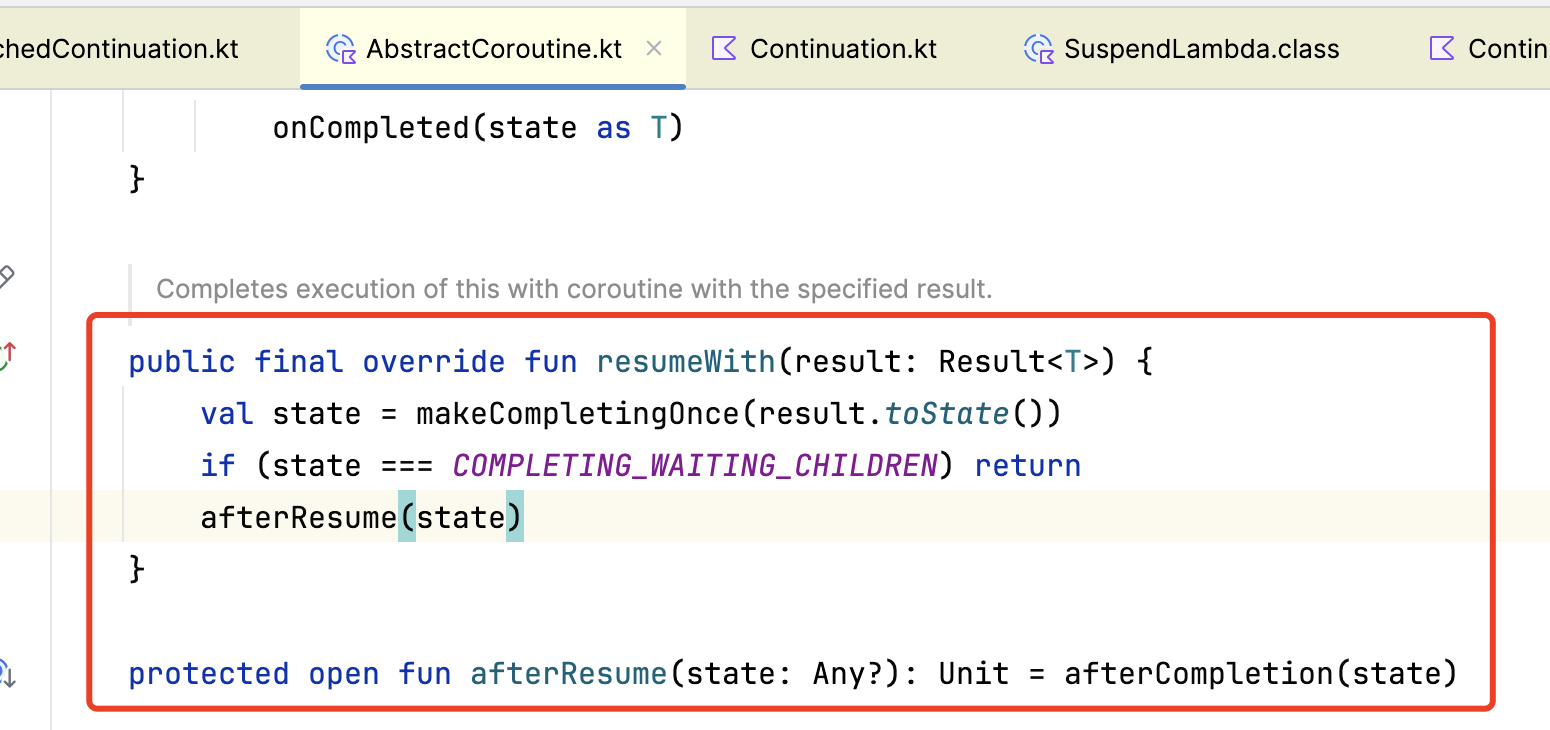 AbstractCoroutine的afterCompletion:
AbstractCoroutine的afterCompletion:
 此处没有逻辑执行。
我们注意到在讲解协程启动的时候,创建delegate的continuation时候调用createCoroutineUnintercepted只传了complete,没有传receiver。而在launch启动协程时候,将StandaloneCoroutine作为receiver传给了createCoroutineUnintercepted方法:
此处没有逻辑执行。
我们注意到在讲解协程启动的时候,创建delegate的continuation时候调用createCoroutineUnintercepted只传了complete,没有传receiver。而在launch启动协程时候,将StandaloneCoroutine作为receiver传给了createCoroutineUnintercepted方法:
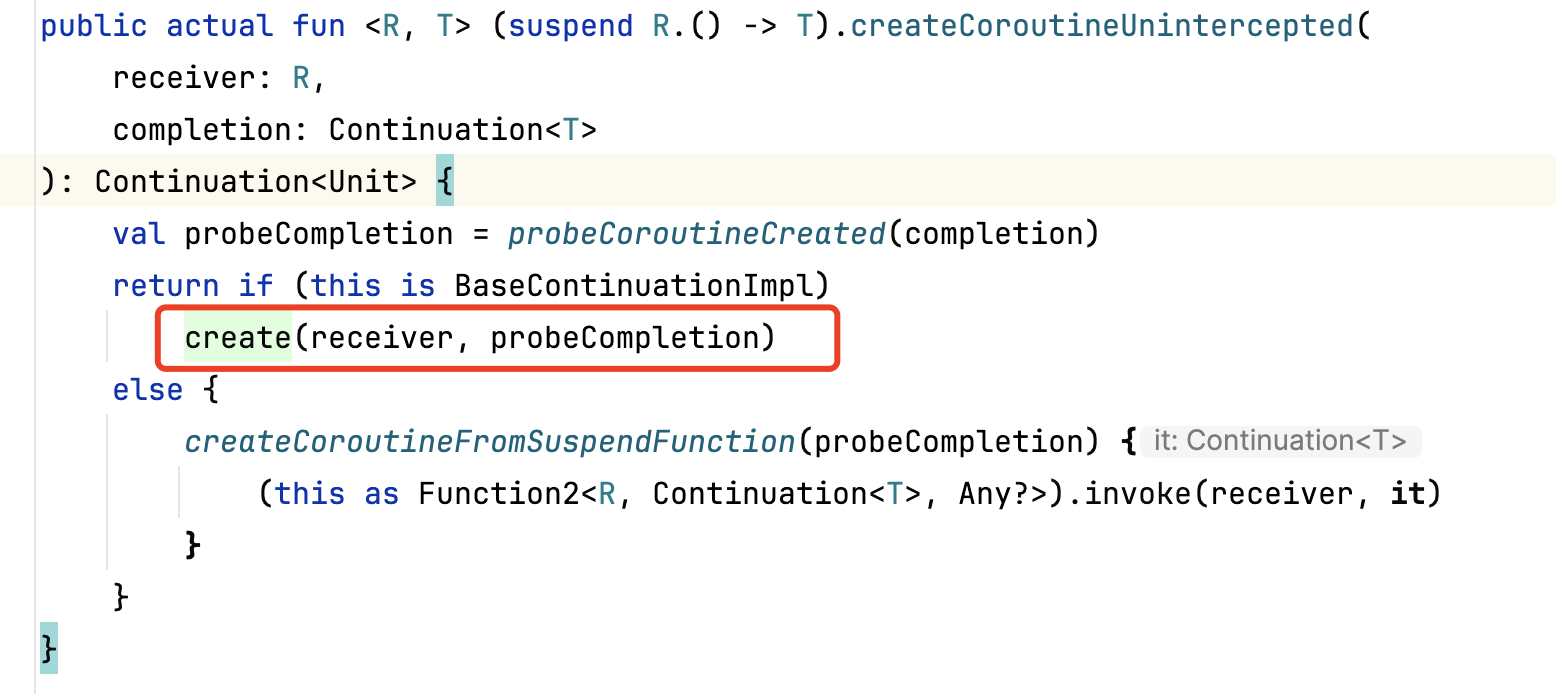 默认的挂起函数的create方法是抛异常的,需要SuspendLambda的子类自己去实现:
默认的挂起函数的create方法是抛异常的,需要SuspendLambda的子类自己去实现:
 编译后的SuspendLambda的子类create实现:
编译后的SuspendLambda的子类create实现:
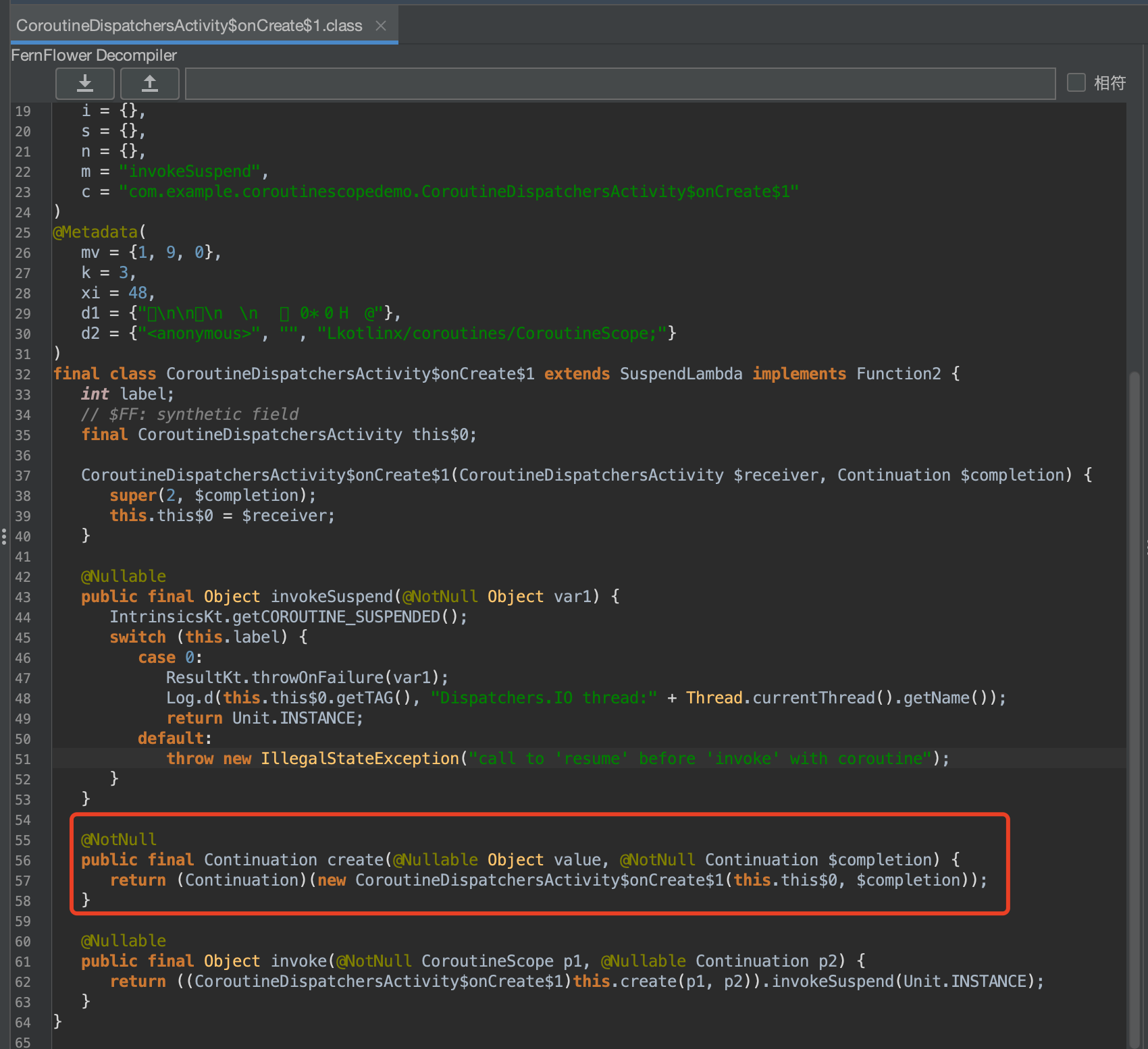 此处将receiver传到create中没有用到,所以其实跟单参没有什么区别啊。
此处将receiver传到create中没有用到,所以其实跟单参没有什么区别啊。
总结
结论:协程在启动过程中会取CoroutineContext中的ContinuationInterceptor,然后执行interceptContinuation。而此时如果是一个Dispatchers.IO,它又是继承自CoroutineDispatcher,所以会执行到了CoroutineDispatcher的interceptContinuation。此时得到的是一个DispatchedContinuation对象,并把当前的CoroutineDispatcher和协程启动过程中创建的StandaloneCoroutine传给了DispatchedContinuation。接着会执行DispatchedContinuation的resumeCancellableWith方法,在该方法里面会判断CoroutineDispatcher.isDispatchNeeded,如果是的话,会调用CoroutineDispatcher的dispatch方法,最终会通过线程池会执行到DispatchedContinuation的run方法,因为它是一个Runnable对象。在run方法里面,会执行continuation的resume方法,而此处的continuation是编译器给我们创建的SuspendLambda的子类,最终会执行它的invokeSuspend方法。执行完后会执行协程启动过程中的StandaloneCoroutine的resumeWith方法。
时序图:
